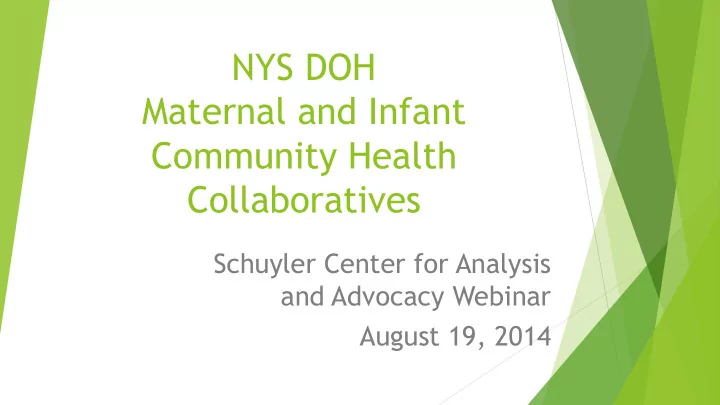

NYS DOH Maternal and Infant Community Health Collaboratives Schuyler Center for Analysis and Advocacy Webinar August 19, 2014
Presenters: Michal Acosta, Associate Director Bureau of Maternal and Child Health Amy Hauptli, MICHC Program Manager Bureau of Maternal and Child Health Perinatal Health Unit
Maternal & Infant Community Health Collaboratives A needs-driven, community-based collaborative approach to improve key birth outcomes — preterm birth, low birth weight, infant mortality and maternal mortality. Life Course Approach Social Ecological Performance Approach Management Strategies addressing… • Enroll women in Strategies impacting… health insurance • Preconception • Ensure women are • Individual/Family • Prenatal/Postpartum engaged in health Level • Interconception care -Community • Coordinate services Health across community Workers programs • Promote • Organizational Level opportunities and • Community Level supports for healthy behaviors 3
MIH Components Maternal and Infant Community Health Collaboratives (MICHC) – 23 projects Maternal, Infant and Early Childhood Home Visiting Initiative (MIECHV) – 10 projects Pathways to Success – 6 projects Maternal and Infant Health – Health Information Technology Pilot Project – 4 projects Maternal and Infant Health Center of Excellence (MIH-COE) – to be established
Maternal and Infant Health Initiative Goal: Improve maternal and infant health outcomes for high- need women and families in targeted communities and reduce racial, ethnic and economic disparities in those outcomes. Preterm birth Low birth weight Infant Mortality Maternal Mortality
Maternal and Infant Health in NYS Low Birth Weight Births by Race/Ethnicity, NYS 2002- 2012 14 12 10 Percent of Live Births 8 6 4 2 0 2002 2003 2004 2005 2006 2007 2008 2009 2010 2011 2012 NYS White Non-Hispanic Black Non-Hispanic Hispanic HP 2020 Target 6
Maternal and Infant Health in NYS Preterm Birth by Race/Ethnicity, NYS 2003-2012 20 18 16 14 Percent of Live Births 12 10 8 6 4 2 0 2003 2004 2005 2006 2007 2008 2009 2010 2011 2012 White Non-Hispanic Black Non-Hispanic Hispanic HP 2020 Target 7
Maternal and Infant Health in NYS Infant Mortality Rate by Race/Ethnicity, NYS 2002-2012 14.0 12.0 Infant Deaths per 1,000 Live Births 10.0 8.0 6.0 4.0 2.0 0.0 2002 2003 2004 2005 2006 2007 2008 2009 2010 2011 2012 NYS Black Non-Hispanic White Non-Hispanic Hispanic HP 2020 Target 8
Maternal and Infant Health in NYS Three-Year Rolling Average Maternal Mortality Rate, NYS and US 2001-2012 35 30 Maternal Deaths per 100,000 Live Births 25 20 15 10 5 0 NYS Rest of State New York City US HP 2020 Target
MICHC Performance Standards High-need women and infants are enrolled in health 1. insurance. High-need women and infants are engaged in health 2. care and other supportive services. Their risk factors are identified and addressed through 3. timely and coordinated counseling, management, referral and follow-up. There are community supports and opportunities in 4. place that help women engage in and maintain healthy behaviors.
Maternal Infant Community Health Collaboratives County Map of Awards
Maternal and Infant Community Health Collaboratives Performance Management Collaborative Approach Systems-based Approach Life Course Model Ecological Model
Collaborative Approach Assessment of Needs and Strengths Development of Improvement Plan Implementation of Improvement Plan
Systems-based Approach Systems that are accessible, effective, and functionally coordinated or integrated can enable service providers to deliver quality services and promote health behaviors and utilize services. Coordinated outreach, intake, and referral processes across community health and social service programs to assure improved communication, collaboration and coordination.
Life Course Model Promotes optimal women’s health throughout the reproductive life span: • Preconception • Perinatal / Postpartum • Interconception
Social Ecological Model Health is influenced by a multitude of factors at different ecological levels. Individual • Community • Organizational • Policy •
MICHC Improvement Strategies Targeted to Medicaid-eligible populations Responsive to community needs and strengths Collaborative Community Health Worker Offering and Arranging Organizational and/or Community level and Individual / Family level strategies
Community Health Workers (CHW) Specially trained paraprofessionals recruited from the target community to work directly with high-need women and their families to access health care and other services and to promote healthy behaviors All 23 MICHC projects have a team of CHWs Provide outreach, education, assistance with access to needed care, and enhanced social support to high-risk pregnant, postpartum, preconception and interconception women 18
Maternal & Infant Community Health Collaboratives + Oral Health Improve oral health outcomes for pregnant women and infants Integrate oral health care into community based perinatal services Increase % of women who visit a dentist during pregnancy Increase % of women who receive an assessment for oral health problems and appropriate referral by a prenatal care provider Increase % of women engaged in healthy behaviors (e.g., appropriate feeding habits, infant oral hygiene practices) Disseminate lessons learned with other MICHCs and states
Summary Promote optimal health across the life span. Strengthen individual knowledge; change organizational practices; mobilize communities; and influence policy. Collaboratively assess community needs and resources, and develop collaborative strategies to address those needs; and Regularly assess progress in implementing strategies, and in achieving desired outcomes.
Questions? Michael Acosta: Michael.Acosta@health.ny.gov Amy Hauptli: Amy.Hauptli@health.ny.gov Bureau of Maternal and Child Health NYS Department of Health (518) 474-1911
Recommend
More recommend